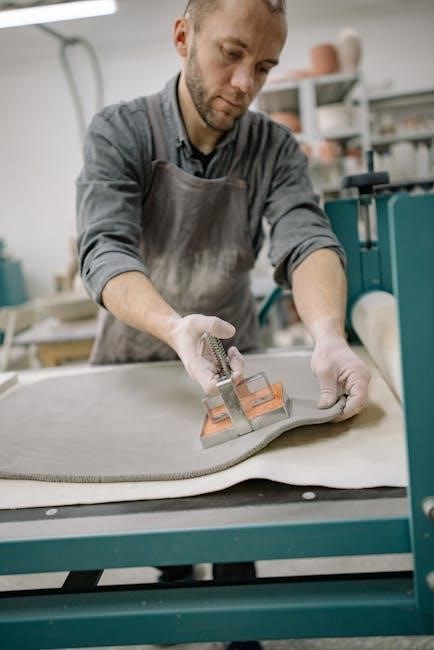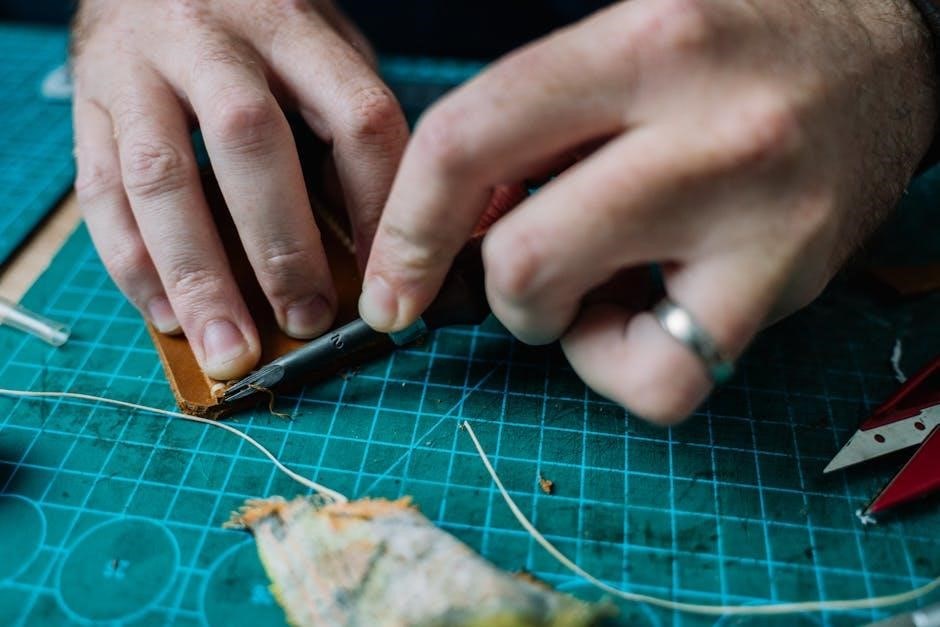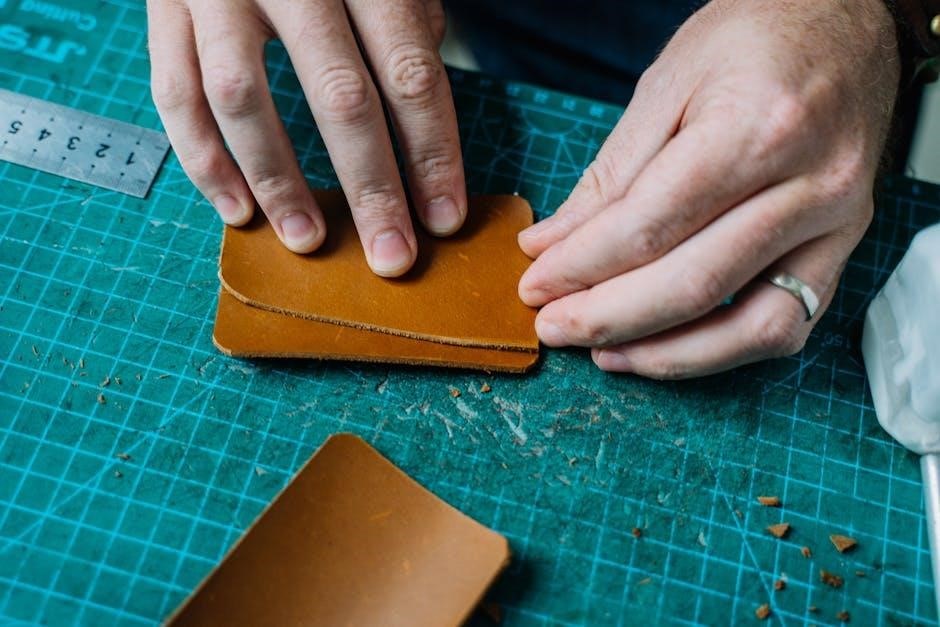Safety Precautions
Always unplug the ice maker before cleaning or maintenance. Avoid overheating by ensuring proper ventilation. Keep children away from hot surfaces and moving parts. Never use abrasive cleaners or sharp objects‚ as they may damage the appliance. Ensure the machine is placed on a stable‚ heat-resistant surface to prevent accidents; Regularly check for wear and tear on electrical components to maintain safety. Avoid using the ice maker near flammable materials or in humid environments. Follow all instructions carefully to prevent electrical hazards. Always refer to the user manual for specific safety guidelines. If unsure about any procedure‚ contact customer support immediately. Properly dispose of packaging materials to avoid choking hazards. Never leave the ice maker unattended during operation. Ensure all cords and connections are secure and dry before use. Avoid using the appliance in extreme temperatures. Always handle the ice maker with care to prevent physical injury. Keep the ice maker out of reach of pets and children to avoid accidental damage or harm. Regularly inspect the power cord for signs of damage or fraying. Do not submerge the ice maker in water or expose it to excessive moisture. Always follow the recommended cleaning procedures to prevent bacterial growth. Never attempt to repair the ice maker yourself; contact a certified technician. Familiarize yourself with the emergency shutdown procedure in case of malfunctions. Ensure the ice maker is properly grounded to prevent electrical shocks. Always store the ice maker in a dry‚ cool place when not in use. Never operate the ice maker with damaged or missing parts. Follow all local electrical safety standards and regulations. Keep the ice maker away from direct sunlight to prevent overheating. Always read the safety precautions section thoroughly before first use. Ensure all safety features are functioning properly before each use. Never use the ice maker near open flames or sparks. Always prioritize safety when handling ice‚ as it may be slippery. Keep emergency contact information handy in case of an accident. Regularly update yourself on any new safety guidelines provided by the manufacturer. Follow all instructions for proper disposal of the ice maker at the end of its lifecycle. Always use genuine replacement parts to ensure safety and performance. Never modify the ice maker in any way‚ as it may void the warranty and compromise safety. Be aware of your surroundings while operating the ice maker to prevent accidents. Keep the user manual in an accessible location for quick reference. Always report any safety concerns to the manufacturer promptly. Ensure all users of the ice maker are aware of and understand the safety precautions. Never operate the ice maker in areas with poor ventilation‚ as it may lead to condensation buildup. Always check for recalls or safety notices related to your specific model. Familiarize yourself with the ice maker’s weight and dimensions to handle it safely during relocation. Never use the ice maker as a storage container for non-ice items. Ensure the ice maker is compatible with your electrical system to prevent overloading. Always respect the ice maker’s capacity to avoid overloading and potential damage. Keep the ice maker’s serial number and purchase information readily available for warranty and support purposes. Never use the ice maker in areas prone to flooding or water exposure. Always follow the recommended maintenance schedule to ensure safe and efficient operation. Be cautious when handling sharp edges or components during maintenance. Ensure all accessories and attachments are used as per the manufacturer’s instructions. Never leave the ice maker operational during extended periods of absence. Always monitor the ice maker’s performance and address any unusual behavior promptly. Keep track of the ice maker’s lifespan and plan for replacement when necessary. Familiarize yourself with local regulations regarding appliance safety and disposal. Always use a grounded power outlet to prevent electrical hazards. Ensure the ice maker is placed on a surface that can withstand its weight and operation. Never attempt to bypass safety features or disable alarms. Always store ice cubes in a clean‚ covered container to maintain hygiene. Be mindful of the ice maker’s noise levels and place it in an appropriate location. Ensure the ice maker is level to prevent imbalance and potential tipping. Never use the ice maker in areas with extreme temperatures or humidity levels. Always follow the manufacturer’s guidelines for cleaning and sanitizing the ice maker. Keep the ice maker’s drain clean and clear to prevent water damage or mold growth. Familiarize yourself with the ice maker’s energy consumption to avoid electrical circuit overload. Always check for any blockages in the ice maker’s components before each use. Ensure the ice maker is used solely for its intended purpose of producing ice. Never use the ice maker in a moving vehicle or unstable environment. Always prioritize energy efficiency and safety when choosing settings for the ice maker. Be aware of the ice maker’s environmental impact and follow eco-friendly practices. Ensure the ice maker is compatible with your water source to prevent contamination. Always follow the recommended water quality guidelines for the ice maker. Never use the ice maker with contaminated or impure water sources. Ensure the ice maker is descaled regularly to prevent mineral buildup and maintain performance. Always check for any recalls or safety alerts issued by the manufacturer. Keep the ice maker’s warranty information and support contacts easily accessible. Familiarize yourself with the ice maker’s environmental specifications and disposal requirements. Never use the ice maker near chemicals or cleaning products to avoid contamination. Always ensure the ice maker is properly assembled and configured before first use. Be cautious when handling the ice maker’s electrical components to prevent shocks. Ensure the ice maker is placed away from direct airflow to maintain consistent operation. Never use the ice maker in areas with high dust levels to prevent internal damage. Always follow the recommended cleaning schedule to maintain the ice maker’s efficiency and safety. Ensure the ice maker’s filter is replaced or cleaned as per the manufacturer’s instructions. Never ignore unusual noises or vibrations‚ as they may indicate a safety issue. Always prioritize regular maintenance to ensure the ice maker operates safely and effectively. Familiarize yourself with the ice maker’s troubleshooting guide to address minor issues promptly. Keep the ice maker’s user manual updated with any new information or guidelines. Ensure the ice maker is used in compliance with all applicable safety standards and regulations. Never operate the ice maker when it is not properly assembled or configured. Always follow the manufacturer’s instructions for transporting or relocating the ice maker. Be aware of the ice maker’s electrical requirements to prevent overloading circuits. Ensure the ice maker is placed on a non-slip surface to prevent accidents. Never use the ice maker in a confined or poorly ventilated space. Always check the ice maker’s components for signs of wear and tear regularly. Familiarize yourself with the ice maker’s error codes and their meanings. Ensure the ice maker is used only with compatible accessories and parts. Never operate the ice maker with the ice basket removed or improperly aligned. Always handle the ice maker’s electrical cord with care to prevent damage. Ensure the ice maker is placed away from heating vents or radiators to prevent overheating. Be cautious when handling ice cubes‚ as they may be slippery or sharp. Always follow the recommended ice storage guidelines to maintain quality and safety. Ensure the ice maker is cleaned and dried thoroughly after each use to prevent mold growth. Never use the ice maker as a toy or allow children to play with it. Always monitor the ice maker’s water level to prevent overflow or shortages. Familiarize yourself with the ice maker’s shut-off procedure in case of an emergency. Ensure the ice maker is compatible with your home’s electrical system to prevent hazards. Never use the ice maker in a bathroom or other high-moisture area. Always follow the manufacturer’s instructions for defrosting and cleaning the ice maker. Be aware of the ice maker’s environmental impact and follow eco-friendly practices. Keep the ice maker’s user manual in a safe and accessible location at all times. Ensure the ice maker is used only for its intended purpose and in accordance with the manufacturer’s guidelines. Always prioritize safety when handling and operating the ice maker to prevent accidents and ensure optimal performance.
1.1. Installation Precautions
When installing your Igloo countertop ice maker‚ ensure it is placed on a stable‚ heat-resistant surface. Avoid positioning it near heating vents‚ radiators‚ or direct sunlight‚ as this may affect performance. Keep the machine at least 4 inches away from any walls or obstacles to ensure proper ventilation. Never install the ice maker in a humid or wet environment‚ as this could damage electrical components. Always place it on a flat‚ level surface to prevent uneven operation. Avoid areas with flammable materials or near open flames. Ensure the ice maker is not exposed to extreme temperatures or vibrations. Before first use‚ allow the machine to stand upright for 24 hours to ensure proper refrigerant distribution. Always follow the manufacturer’s guidelines for installation to ensure safety and optimal performance;

1.2. Usage Precautions
Always follow the manufacturer’s guidelines for safe and efficient operation of your Igloo countertop ice maker. Never leave ice cubes in the machine for extended periods‚ as they may melt and cause water damage. Regularly clean the machine before and after use to prevent mold or bacteria growth. Keep children away from moving parts and hot surfaces. Ensure the machine is placed on a stable‚ level surface during operation. Avoid overloading the ice maker beyond its recommended capacity. Always use the machine in an upright position and ensure the drain is clear. Never use abrasive cleaners or sharp objects‚ as they may damage the interior. Monitor the ice size selection to avoid improper ice formation. Always unplug the machine when not in use or during cleaning. Handle the ice maker with care to prevent accidental damage or injury.
1.3. Maintenance Precautions
Regular cleaning and descaling are essential to maintain your Igloo countertop ice maker’s performance and longevity. Always unplug the machine before performing any maintenance tasks. Use a soft cloth and mild detergent to clean the exterior and interior components. Avoid using abrasive cleaners or scrubbers‚ as they may damage the surfaces; Descale the machine every 1-3 months‚ depending on usage‚ to prevent mineral buildup. Check and clean the water filter regularly to ensure proper water flow and ice quality. Inspect the drain and ensure it is clear of blockages to prevent water accumulation. Never use harsh chemicals or bleach‚ as they may damage the appliance or leave harmful residues. After cleaning‚ dry the machine thoroughly to prevent mold or mildew growth. Always refer to the user manual for specific maintenance instructions. Schedule professional maintenance if you notice any significant issues or performance decline. Regularly inspect electrical components for signs of wear or damage. Use only recommended cleaning solutions and replacement parts to maintain warranty validity. Drain and dry the machine completely after each use to prevent freezing or water damage. Avoid using the machine in extreme temperatures or humid environments‚ as this may affect its functionality. Always store the machine in a dry‚ cool place when not in use for extended periods. Follow a regular maintenance schedule to ensure optimal performance and extend the lifespan of your Igloo countertop ice maker.

Product Features
The Igloo countertop ice maker offers a portable‚ compact design with a sleek appearance. It produces up to 26 pounds of ice daily in two size options. The machine features an easy-to-use control panel‚ a transparent lid for monitoring ice production‚ and a convenient ice basket with a handle. Its self-cleaning function ensures maintenance is hassle-free. The ice maker is energy-efficient‚ quiet‚ and perfect for home‚ office‚ or outdoor use. With its modern design and user-friendly interface‚ it enhances convenience while providing consistent ice production.

2.1. Design and Build
The Igloo countertop ice maker features a sleek‚ modern design with a compact and lightweight build‚ making it easy to move and place on any countertop. Its durable construction ensures long-lasting performance‚ while the user-friendly interface simplifies operation. The transparent lid allows for easy monitoring of ice production‚ and the interior components are designed for efficient ice making. The machine’s self-cleaning function enhances maintenance and hygiene. Built with high-quality materials‚ it ensures reliability and safety. The energy-efficient design minimizes power consumption‚ making it an eco-friendly choice. Its quiet operation and compact size make it ideal for small spaces‚ such as kitchens‚ offices‚ or outdoor settings. The ice maker’s design prioritizes convenience‚ durability‚ and aesthetics‚ ensuring it blends seamlessly into any environment while delivering consistent performance.
2.2. Ice Making Capacity

The Igloo countertop ice maker offers an impressive ice-making capacity‚ producing up to 26 pounds of ice per day. It features a 1.5-pound ice basket‚ allowing you to store freshly made ice for convenient access. The machine is designed to efficiently produce ice in as little as 6-8 minutes per batch‚ making it ideal for entertaining or everyday use. With the ability to choose between small and large ice sizes‚ it caters to various preferences and needs. The ice maker’s compact design doesn’t compromise on capacity‚ ensuring ample ice production for small gatherings or personal use. Regular cleaning and proper maintenance can help maximize its ice-making efficiency. This model is perfect for those seeking a reliable and high-capacity ice maker that fits neatly on any countertop. Its performance and capacity make it a great addition to any kitchen or outdoor setting.

2.3. Ice Size Options
The Igloo countertop ice maker offers two convenient ice size options: small and large cubes. This feature allows users to customize ice production based on their preferences or specific needs. To select the desired ice size‚ simply press the “Select” button until the corresponding indicator light illuminates. Small ice cubes are ideal for beverages like cocktails or water glasses‚ while large cubes are perfect for cooling drinks in larger containers or for slower melting in situations like outdoor gatherings. The machine ensures consistent ice size and quality for both settings. This versatility makes the Igloo ice maker a practical choice for various occasions‚ from everyday use to entertaining guests. The ability to switch between sizes easily enhances user convenience and satisfaction‚ catering to different lifestyles and preferences. This feature is a standout aspect of the product’s design and functionality.

Installation and Setup

Place the Igloo ice maker on a stable‚ flat surface. Ensure proper drainage by positioning the drain cap correctly. Follow the initial setup steps in the manual for optimal performance.
3.1. Placement Recommendations

Position the Igloo countertop ice maker on a stable‚ flat surface to ensure proper operation. Choose a location with good ventilation to avoid overheating. Place it away from direct sunlight and heat sources. Ensure the ice maker is level to prevent imbalance and uneven ice production. Keep it at least 4 inches away from any walls or other appliances to allow proper airflow. Avoid placing it in humid or extreme-temperature environments. Select a countertop that can support the weight of the unit when full of water and ice. Ensure the power cord can reach a nearby outlet without being stretched or damaged. For optimal performance‚ place the ice maker on a heat-resistant and waterproof surface. Keep it away from children and pets to avoid accidental damage. Ensure the drain is accessible for easy water disposal. Place the ice maker in an area where it won’t be exposed to vibrations or movement. Choose a location with easy access for monitoring and maintenance. Ensure the surface is clean and dry before placing the ice maker to prevent slipping. Avoid placing it in areas prone to moisture or condensation buildup. Keep it away from flammable materials and open flames. Ensure the ice maker is positioned on a surface that can withstand minor water spills. Place it in an area with minimal foot traffic to reduce the risk of accidental knocks. Ensure the ice maker is not placed near any electrical hazards or water sources. Choose a location where the ice maker can operate quietly without disturbing others. Keep it away from direct airflow from vents or fans to maintain consistent operation. Ensure the ice maker is placed on a surface that allows easy cleaning and maintenance. Avoid placing it in confined or poorly ventilated spaces. Keep it away from chemicals or cleaning products to prevent contamination. Ensure the ice maker is positioned in a way that allows easy access to the control panel. Place it in a location where the ice basket can be easily removed and replaced. Ensure the ice maker is not placed near any sharp objects that could cause damage. Keep it away from areas with high dust levels to prevent internal contamination. Ensure the ice maker is positioned on a surface that is resistant to water spots or mineral deposits. Place it in a location where the ice maker can be easily monitored during operation. Avoid placing it in areas with strong odors or fumes to prevent contamination. Ensure the ice maker is placed on a surface that allows proper drainage and water management. Keep it away from any electrical appliances that could interfere with its operation. Place it in a location where the ice maker can be easily moved for cleaning or maintenance. Ensure the ice maker is positioned on a surface that is stable and will not shift during use. Avoid placing it in areas with extreme temperature fluctuations. Keep it away from any materials that could melt or deform due to proximity to the ice maker. Ensure the ice maker is placed on a surface that is easy to sanitize and maintain. Place it in a location where the ice maker can be easily accessed for troubleshooting. Ensure the ice maker is positioned on a surface that is compatible with its dimensions and weight. Keep it away from any objects that could obstruct its operation or airflow. Place it in a location where the ice maker can be easily stored when not in use. Ensure the ice maker is positioned on a surface that is protected from power surges or electrical spikes. Avoid placing it in areas with high humidity or exposure to outdoor weather. Keep it away from any chemicals or substances that could damage the appliance. Ensure the ice maker is placed on a surface that is resistant to mold and mildew growth. Place it in a location where the ice maker can be easily cleaned and dried after each use. Ensure the ice maker is positioned on a surface that is free from clutter or obstacles. Keep it away from any sources of vibration or noise that could affect its operation. Place it in a location where the ice maker can be easily monitored for any signs of wear or damage. Ensure the ice maker is positioned on a surface that is easy to inspect and maintain. Avoid placing it in areas with poor lighting‚ as it may hinder monitoring. Keep it away from any materials that could cause static electricity or interference. Ensure the ice maker is placed on a surface that is resistant to scratches or marks. Place it in a location where the ice maker can be easily accessed for regular maintenance. Ensure the ice maker is positioned on a surface that is free from grease or oil to prevent slipping. Keep it away from any sharp edges or corners that could cause damage. Place it in a location where the ice maker can be easily moved without causing injury. Ensure the ice maker is positioned on a surface that is compatible with its power requirements. Avoid placing it in areas with limited electrical outlets or overloaded circuits. Keep it away from any sources of electromagnetic interference that could disrupt its operation. Ensure the ice maker is placed on a surface that is resistant to water damage or warping. Place it in a location where the ice maker can be easily stored during extended periods of non-use. Ensure the ice maker is positioned on a surface that is protected from pests or rodents. Keep it away from any materials that could attract dust or dirt. Ensure the ice maker is placed on a surface that is easy to clean and maintain. Place it in a location where the ice maker can be easily accessed for warranty or support services. Ensure the ice maker is positioned on a surface that is compatible with its environmental specifications. Keep it away from any sources of UV light or direct radiation that could cause damage. Ensure the ice maker is placed on a surface that is resistant to fading or discoloration. Place it in a location where the ice maker can be easily monitored for any signs of malfunction. Ensure the ice maker is positioned on a surface that is free from any obstacles that could hinder its operation. Keep it away from any materials that could cause corrosion or rust. Ensure the ice maker is placed on a surface that is resistant to stains or spills. Place it in a location where the ice maker can be easily accessed for troubleshooting or repair. Ensure the ice maker is positioned on a surface that is compatible with its weight distribution. Keep it away from any sources of strong magnetic fields that could interfere with its operation. Ensure the ice maker is placed on a surface that is resistant to cracking or breaking. Place it in a location where the ice maker can be easily moved without causing damage to the surface. Ensure the ice maker is positioned on a surface that is free from any hazards that could cause accidents. Keep it away from any materials that could cause electrical shocks or fires. Ensure the ice maker is placed on a surface that is resistant to wear and tear. Place it in a location where the ice maker can be easily accessed for regular inspections. Ensure the ice maker is positioned on a surface that is compatible with its dimensions and design. Keep it away from any sources of noise or vibrations that could affect its performance. Ensure the ice maker is placed on a surface that is resistant to moisture or humidity. Place it in a location where the ice maker can be easily stored when not in use. Ensure the ice maker is positioned on a surface that is free from any materials that could cause contamination. Keep it away from any sources of pollution or fumes that could affect the quality of the ice. Ensure the ice maker is placed on a surface that is resistant to heat or cold extremes. Place it in a location where the ice maker can be easily accessed for cleaning and maintenance. Ensure the ice maker is positioned on a surface that is compatible with its power cord and electrical requirements. Keep it away from any sources of water splashes or leaks that could cause electrical hazards. Ensure the ice maker is placed on a surface that is resistant to mineral buildup or scaling. Place it in a location where the ice maker can be easily monitored for any signs of wear or damage. Ensure the ice maker is positioned on a surface that is free from any obstacles that could hinder its operation. Keep it away from any materials that could cause static electricity or interference. Ensure the ice maker is placed on a surface that is resistant to scratches or marks. Place it in a location where the ice maker can be easily accessed for regular maintenance. Ensure the ice maker is positioned on a surface that is free from grease or oil to prevent slipping; Keep it away from any sharp edges or corners that could cause damage. Place it in a location where the ice maker can be easily moved without causing injury. Ensure the ice maker is positioned on a surface that is compatible with its power requirements. Avoid placing it in areas with limited electrical outlets or overloaded circuits. Keep it away from any sources of electromagnetic interference that could disrupt its operation. Ensure the ice maker is placed on a surface that is resistant to water damage or warping. Place it in a location where the ice maker can be easily stored during extended periods of non-use. Ensure the ice maker is positioned on a surface that is protected from pests or rodents. Keep it away from any materials that could attract dust or dirt. Ensure the ice maker is placed on a surface that is easy to clean and maintain. Place it in a location where the ice maker can be easily accessed for warranty or support services. Ensure the ice maker is positioned on a surface that is compatible with its environmental specifications. Keep it away from any sources of UV light or direct radiation that could cause damage. Ensure the ice maker is placed on a surface that is resistant to fading or discoloration. Place it in a location where the ice maker can be easily monitored for any signs of malfunction. Ensure the ice maker is positioned on a surface that is free from any obstacles that could hinder its operation. Keep it away from any materials that could cause corrosion or rust. Ensure the ice maker is placed on a surface that is resistant to stains or spills. Place it in a location where the ice maker can be easily accessed for troubleshooting or repair. Ensure the ice maker is positioned on a surface that is compatible with its weight distribution. Keep it away from any sources of strong magnetic fields that could interfere with its operation. Ensure the ice maker is placed on a surface that is resistant to cracking or breaking. Place it in a location where the ice maker
3.2. Leveling the Machine
To ensure proper operation‚ the Igloo countertop ice maker must be placed on a level surface. Before first use‚ check the surface with a spirit level. If the surface is uneven‚ adjust the machine’s feet (if applicable) or place it on a stable‚ flat object like a cutting board. Ensure all four corners of the ice maker are in contact with the surface to prevent tilting. Improper leveling can lead to uneven ice production or water leakage. Use a bubble level to verify the machine is perfectly horizontal. If no adjustable feet are present‚ consider using leveling pads or shims to achieve balance. After leveling‚ ensure the machine is stable and does not wobble. Recheck the level periodically‚ especially if the machine is moved. Proper leveling ensures efficient ice production and prevents mechanical issues.

Warranty and Support
3.3. Initial Setup Steps
Before first use‚ carefully unpack the Igloo countertop ice maker and inspect for any damage; Remove all packaging materials and wash your hands. Clean the ice basket and interior with a mild detergent and rinse thoroughly. Dry the machine with a soft cloth. Place the ice maker on a level‚ stable surface as directed. Remove the ice basket and pour out any excess water from the reservoir. Allow the machine to stand upright for 24 hours before use to ensure proper refrigerant circulation. Plug in the machine and ensure the power button is off. Refer to the user manual for specific initial setup instructions. Follow all safety guidelines to prevent damage or injury. Proper initial setup ensures optimal performance and longevity of the ice maker. Always follow the manufacturer’s recommendations for the first use.